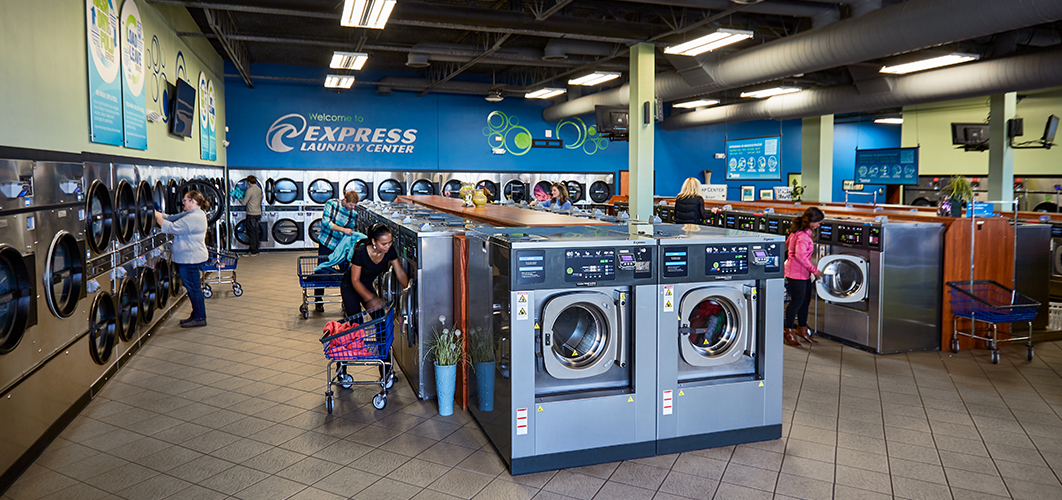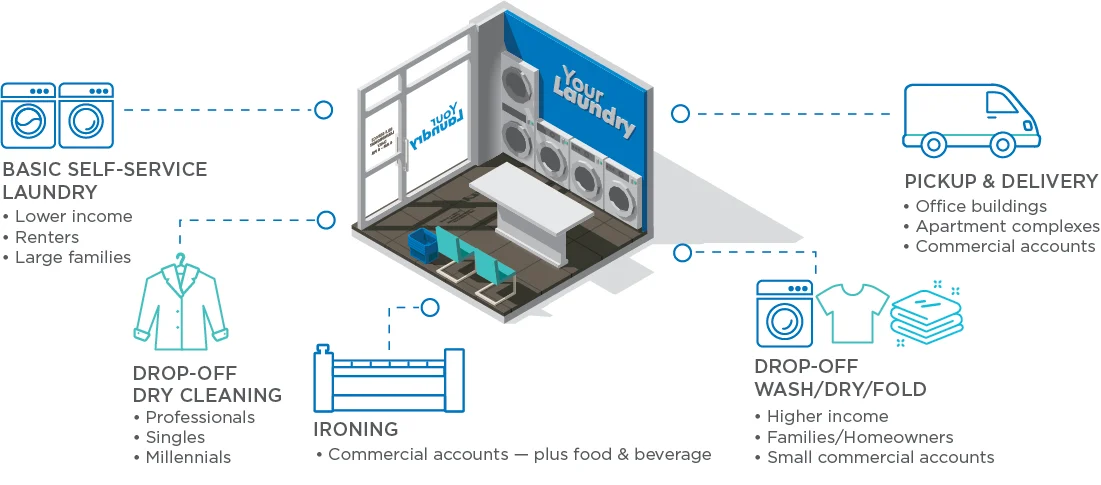All vended laundries are different and cater to a unique demographic. No two locations are the same. In order to maximize revenue generated from that demographic, it makes sense to appeal to its diversity.
Consider offering services — from your laundry hub — that go beyond the self-service customer. Create services that appeal to homeowners, professionals, singles and nearby businesses. As you transition your laundry into a service center, help the market realize how you can serve them. By offering solutions that appeal to your entire demographic, you’ll better penetrate your market, create multiple, diverse revenue streams and grow store revenue and profit — all while better-utilizing equipment and labor.
Demographics & Distributors
The first step is to analyze your demographic and evaluate the services you offer with new services you might introduce. This is as important for the store that’s just opening as it is for the store that’s been in business for years. Expect that demographic report to help you build a profile for your laundry’s customer base. It provides data detailing income level, gender, race, education level, homeownership, occupation and marital status, among others.
Get in touch with your equipment distributor for assistance. Distributors understand their local markets well and will tell you if your unique demographics can support an additional service. Your distributor does more than simply sell equipment. A quality distributor will run the demographic report and evaluate it; analyze competitors and their services; evaluate store layout and space requirements; and provide a proforma. This is a cash flow summary that overviews capital outlay, return on investment, wash and dry income, services income, taxable income, losses, expenses and more. The proforma illuminates the numbers in black and white so it’s easier to determine if adding a new service makes financial sense.
A vended laundry might embrace multiple services in order to better penetrate its demographic. John Stuckey, owner of four Wash World laundries in Omaha, Neb., offers several services for this reason. That’s why his laundries — in addition to self-serve — offer wash/dry/fold, drop-off dry cleaning and full-service pickup and delivery of residential and commercial laundry. “It’s been our philosophy all along that a full combination of services evens the ups and downs of a strictly self-service business,” he said. “It evens out the cash flow stream.” In the past five years, he’s purchased two Continental flatwork ironers to broaden that offering. Now, Wash World laundries serve food & beverage businesses that require ironed table linens. For Stuckey, each service adds to gross revenue while more fully utilizing labor and equipment.
To capture business from mid- and high-income homeowners, professionals or local businesses, such as spas and motels, most vended laundries start by initiating drop-off wash/dry/fold and dry cleaning.
Drop-Off Dry Cleaning
Be certain to partner with a reputable dry cleaner, warns Dan Sofranko, owner of Perfect Wash (Perfect Wash) Express Laundry Center, in Huntington Beach, Calif. “I partner with a great dry cleaner so it’s well worth it because it adds to the customer’s top-of-mind image that laundry gets done right with us,” he said.
By offering drop-off dry cleaning, Sofranko draws men and women looking to dry clean higher-end garments and business attire. When customers drop garments off, they’re bound to make note of the other services offered. The goal is for customers to return to wash their comforters in Sofranko’s big washers, or to take advantage of full-service wash/dry/fold? It’s a great way to drive more business to your store. While the revenue drop-off dry cleaning generates might be a small percentage of sales, it still adds to the bottom line. Plus, it sets the stage for a bigger moneymaker — wash/dry/fold.
Drop-Off Wash/Dry/Fold
Drop-off wash/dry/fold attracts higher-income customers who don’t have the time or desire to do laundry themselves, as well as local businesses in need of clean towels or sheets. Additionally, wash/ dry/fold service appeals to customers looking to clean bulky items, including comforters, boat covers, blankets and more. Wash/dry/ fold harnesses attendant labor and idle equipment to create a new revenue stream and maximize profit per square foot.
A recent Coin Laundry Association (CLA) survey found that 56 percent of responding laundries offer drop-off wash/dry/fold services. According to the CLA, the average family spends $12 per week at a vended laundry. Wash/dry/fold service quadruples that amount, allowing laundries to move from generating $12 per family to $45 or $60! At Sofranko’s laundry, wash/dry/fold makes up 47 percent of total business.
Ironing
A measly 7 percent of laundry owners offer ironing services, according to the CLA survey. Yet, doing so can catapult business! If you already enjoy a solid wash/dry/fold business and have the room, by all means, install an ironer. While a flatwork ironer can allow you to capture more commercial accounts, it requires about 60 square feet of dedicated space.
Several laundry owners, like Stuckey, agree that owning an ironer is a game-changer. Each successfully captured larger commercial accounts, even when the percentage of ironed goods was small Additionally, they experienced a return on their investment in less than a year. Paul said sales jumped because of his ability to iron sheets and pillowcases. “That single piece of equipment allowed me to do work for massage therapists, spas and acupuncturists,” he said. “They started talking about my business to friends. Then business boomed.”
Similarly, Stucky picked up accounts from cosmetic surgeons, massage therapists and party rental companies. He uses the ironer in combination with highly programmable on-premise washers to properly clean and finish spa and table linens. The ironer addition elevated profits $800 per week. It’s been in use there for 15 years!
Pickup & Delivery
Like ironing, pickup and delivery service can take wash/dry/fold revenue to new heights by allowing laundries to expand their market reach and attract new residential and commercial business. But, is it worth the investment of a vehicle, driver, insurance costs and advertising? Stuckey thinks so.
“Adding pickup and delivery increases expenses, but I already have the equipment and most of the labor assets sitting there. I believe if there is any way to make that equipment run, it will end up paying for the additional expenses,” he said. “It’s about economy of scale. The bigger business gets, the more profitable it becomes.”
Sofranko agrees. Launched a couple of years ago, Sofranko’s pickup and delivery now generates the lion’s share of his total wash/dry/fold revenue. “I knew I could only capture certain commercial customers by having pickup and delivery,” he said. “So, I eased into it. The initial investment takes a while to pay off, so invest when you know you can afford to.”
Embrace Multiple Services, Customers & Revenue Streams
What can we learn from all this? The business is out there. It just might not be in the form of the traditional self-service customer. So, look into your demographic, contact your distributor, run a proforma and evaluate the pros and cons of launching more services from your laundry hub. Rely on these services to attract your store’s diverse demographic and generate added revenue and profit!
Tod Sorensen is a regional business manager at Girbau North America and vice president of Continental Girbau West, a full-service distributorship serving the Southern California, Arizona and New Mexico vended, on-premise and industrial laundry markets. He holds more than 20 years of experience in vended laundry development and market analysis. Please contact him with any questions at tsorensen@gnalaundry.com or call 866-950-2449.



